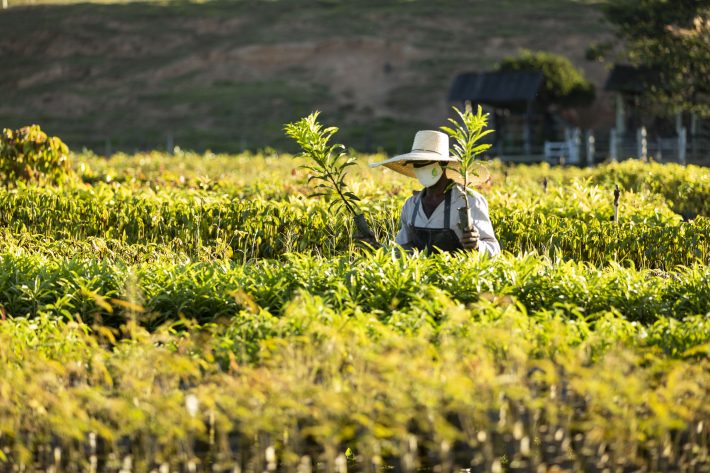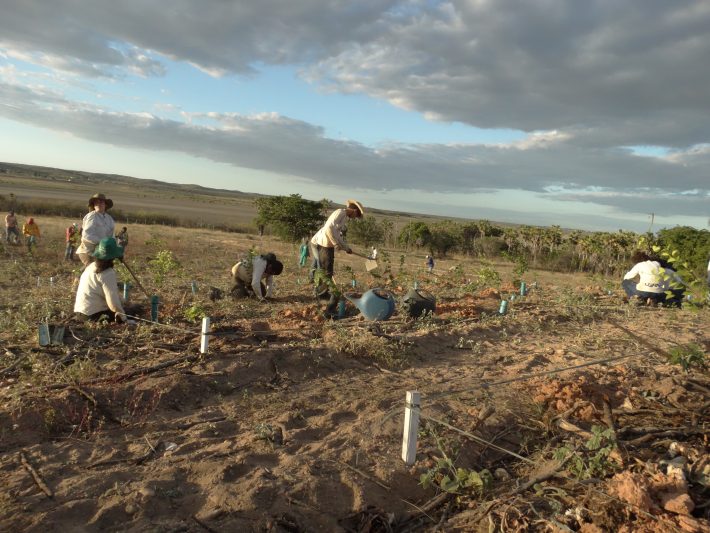Brazil’s ecosystem restoration benefits both people and planet
The Nature Conservancy press release.
An unprecedented study in the British Ecological Society’s Journal People and Nature showcases the potential to generate up to 2.5 million jobs directly through the ecosystem restoration supply chain, if Brazil meets its goal of restoring 12 million hectares of degraded land by 2030.

Coordinated by researchers Pedro Brancalion, professor at the University of São Paulo (ESALQ-USP), and Rafael Chaves, an environmental specialist at the Secretariat for Infrastructure and Environment of the State of São Paulo, this new study shows active forest restoration in Brazil has the potential to generate 0.42 jobs per hectare. This means that for every 2 hectares of degraded lands (equivalent to two football fields) restored, a new job will be generated.
As part of the United Nations Decade on Ecosystem Restoration, Brazil has agreed to a climate commitment to restore 12 million hectares of degraded land by 2030. Referred to as the National Plan for the Recovery of Native Vegetation (Planaveg), this ambitious plan lays out scenarios which will see between 20 and 50% active restoration across degraded sections of Brazil’s landscape. Based on these scenarios the potential to generate jobs through ecosystem restoration varies from 1 to 2.5 million new roles.
“Ecosystem restoration is an emerging economic activity with the potential to generate millions of jobs and income”
In addition to environmental gains, this reversal of environmental degradation can bring multiple social and economic benefits such as the generation of employment opportunities and income through the restoration supply chain. This is shown in an unprecedented study carried out by the Brazilian Society for Ecological Restoration (SOBRE), Atlantic Forest Restoration Pact, Alliance for the Restoration of the Amazon, and the Brazilian Coalition on Climate, Forest, and Agriculture, with the support of important institutions in Brazil’s restoration agenda such as The Nature Conservancy (TNC) Brazil and the World Resources Institute (WRI) Brazil.
According to environmental specialist Rafael Chaves, the restoration of ecosystems benefits the society in multiple spheres. Although the environmental gains are usually awarded greater recognition, the study highlights the social and economic benefits and their impact on the quality of life for people and communities.“Unlike the medium and long-term benefits from restoration, jobs are generated from the beginning of the restoration process through seed collection, seedling production, planting, maintenance and monitoring”, explains the former president of SOBRE.
Regional spread of Brazil’s ecosystem restoration work
The study delved into the spatial spread of Brazil’s restoration projects. The authors showed most restoration initiatives are concentrated in the Southeast region of Brazil (61%), with 30% in the state of São Paulo. Moreover, most jobs are generated partially or totally in the Atlantic Forest biome (85%), a pioneer in restoration activities in Brazil.
This data highlights the need to develop a forest restoration supply chain in other Brazilian regions and biomes. For professor Pedro Brancalion this study’s importance lies in the identification of areas for scaled up restoration – highlighting opportunities to improve public policies concerning landowner incentivisation, Not only will such an ambitious ecosystem restoration project have a tremendous impact on climate change mitigation and adaption at local, regional, and global levels, but this paper highlights opportunities to transform restoration efforts into a large-scale economic activity with benefits to all of society.

“The positive results that can come from the restoration supply chain depend on long-term financing commitments, equitably distributed among Brazilian regions and biomes. In addition, it is worth noting that ecosystem restoration is an emerging economic activity with the potential to generate millions of jobs and income, especially for local organisations and communities”, explains the agronomist.
“Restoration is an opportunity to generate high-quality jobs and income for local people and communities”
This opinion is shared by restoration experts at TNC Brazil, who contributed to data collection and analysis of the results. Julio Tymus adds that job opportunities can leverage additional investments to implement and maintain restoration in the long-term.
“Investing in ecosystem restoration brings numerous environmental, economic and social benefits, but to ensure success, planning and development of short, medium and long-term strategies are needed, in addition to public policies and incentives to increase the scale and impact of restoration”, explains Tymus.
The study also showed the impact of the Covid-19 pandemic on the restoration supply chain. According to the data and results, in the beginning of 2020 a total of 4,713 temporary jobs and 3,510 permanent jobs were created through the restoration supply chain. Approximately 60% of those jobs were generated by organisations specialising in restoration, mainly non-for-profit (48%) and private sector (37%) organisations. However, almost 20% of those jobs were lost during the pandemic in 2020. Additional investments, public policies, and incentives for ecosystems restoration are great opportunities to minimise the impact of COVID-19 by creating thousands of jobs in the short term.

The online survey was carried out in 2020, with the participation of 356 institutions engaged in the restoration supply chain and distributed across the country. This survey also supported the development of a Restoration Showcase, a portal that brings together organisations working with restoration in Brazil and facilitates contact with those interested in restoration. The Restoration Showcase is available for public access on SOBRE website, which also includes a policy brief (in Portuguese), the main highlights of the study applicable in the national context, and the article Potential of Ecosystem Restoration for Job Creation in Brazil.
The scale of Brazil’s ecosystem restoration projects
As part of the strategy to overcome barriers and increase the scale of restoration in Brazil, several restoration networks and movements were established over the last 10+ years to address knowledge gaps and enable the exchange of experiences and expertise. A good example is the Atlantic Forest Restoration Pact (Pact), a multi-sector movement composed of more than 300 members with the goal to restore 15 million hectares of degraded lands and forests by 2050.
Ludmila Pugliese, study coauthor and Pact coordinator, emphasises the essential element of integrating and articulating the efforts of different organisations to increase the scale and impact of restoration initiatives and meet Brazils climate commitments. “The study shows that restoration is an opportunity to generate high-quality jobs and income for local people and communities, bringing social, environmental and economic benefits to Brazil”.
In addition to the Pact, other regional initiatives, such as the Alliance for the Restoration of the Amazon, Articulation for the Restoration of Cerrado (Araticum), Southern Network for Ecological Restoration and Trinational Network and Restoration of Atlantic Forest, in synergy with Brazilian Society for Ecological Restoration (SOBRE) at national level., have emerged in Brazil with the aim of articulating those involved, integrating initiatives, and gaining scale in ecosystems’ restoration.
You can read the full research article for free here:
https://besjournals.onlinelibrary.wiley.com/doi/epdf/10.1002/pan3.10370
Like what we stand for?
Support our mission and help develop the next generation of ecologists by donating to the British Ecological Society.